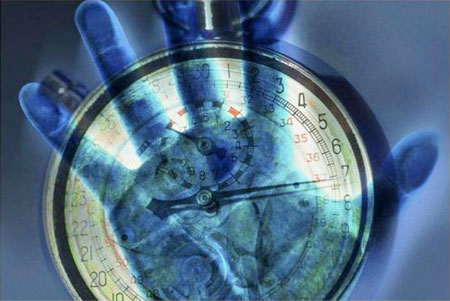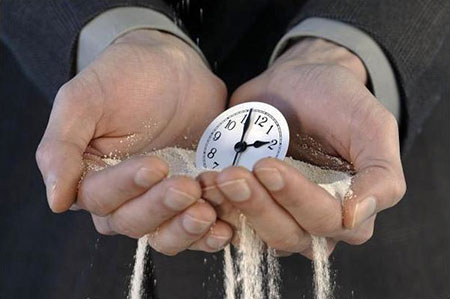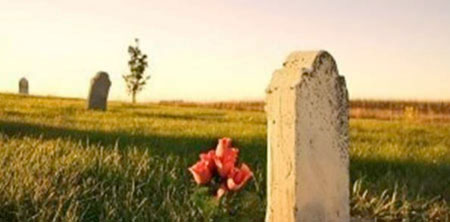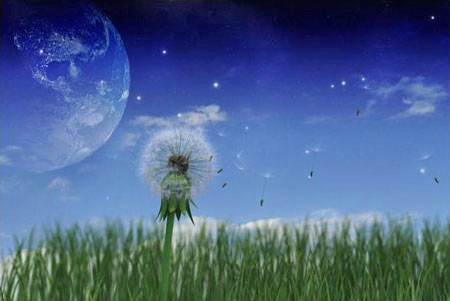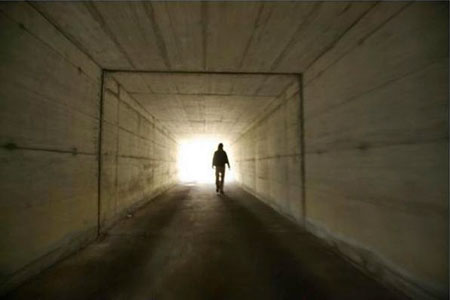|
|
|
by Robert Lanza, MD
2009-2011
Does Death Exist? - New Theory Says 'No'
We believe in death because we have been
told we will die. We associate ourselves with the body, and we know
that bodies die. But a new scientific theory suggests that death is
not the terminal event we think. One well-known aspect of quantum physics is that certain observations cannot be predicted absolutely.
Instead, there is a range of possible observations each with a different probability. One mainstream explanation, the "many-worlds" interpretation, states that each of these possible observations corresponds to a different universe (the 'multiverse').
A new scientific theory - called biocentrism - refines these ideas. There are an infinite number of universes, and everything that could possibly happen occurs in some universe. Death does not exist in any real sense in these scenarios.
All possible universes exist simultaneously, regardless of what happens in any of them. Although individual bodies are destined to self-destruct, the alive feeling - the 'Who am I?'- is just a 20-watt fountain of energy operating in the brain.
But this energy doesn't go away at
death. One of the surest axioms of science is that energy never
dies; it can neither be created nor destroyed. But does this energy
transcend from one world to the other?
Later on, the experimenter could turn a second switch on or off. It turns out that what the observer decided at that point, determined what the particle did in the past.
Regardless of the choice you, the observer, make, it is you who will experience the outcomes that will result. The linkages between these various histories and universes transcend our ordinary classical ideas of space and time.
Think of the 20-watts of energy as
simply holo-projecting either this or that result onto a screen.
Whether you turn the second beam splitter on or off, it's still the
same battery or agent responsible for the projection.
The same thing applies for time. You
can't see anything through the bone that surrounds your brain.
Everything you see and experience right now is a whirl of
information occurring in your mind. Space and time are simply the
tools for putting everything together.
In the end, even Einstein admitted,
Immortality doesn't mean a perpetual
existence in time without end, but rather resides outside of time
altogether.
Experiments suggest the answer is
simpler than anyone thought. Without the glue of consciousness, time
essentially reboots.
It lies deeper. It involves our very selves. We awake in the present. There are stairs below us that we appear to have climbed; there are stairs above us that go upward into the unknown future.
But the mind stands at the door by which
we entered and gives us the memories by which we go about our day.
Everything is ordered and predictable. We're like cuckoo birds who
appear through a door each morning. We fancy there's a clockwork set
in motion at the beginning of time.
The same applies for time - you can't
put it in a jar. You can't see through the bone surrounding your
brain (everything you experience is information in your mind).
Biocentrism tells us space and time aren't objects - they're the
mind's tools for putting everything together.
Mr. O'Donnell pounded metal on his
anvil all day. No, I thought, I didn't want to be caught by him.
Yet, I had my purpose.
When I looked up, I saw Mr. O'Donnell
standing there, his eyes glaring. I said nothing, trying to restrain
myself from crying. "Give me that trap, child," he said, "and come
with me."
Starting the forge, Mr. O'Donnell tossed the trap over the coals and a tiny flame appeared underneath, getting hotter until, with a puff it burst into flame.
When the trap was red hot, he took it from the forge, and pounded it into a little square with his hammer. He said nothing while the metal cooled.
At length, he patted me upon the shoulder, and then took up a few sketches of a dragonfly.
I said that would be fun, and when I
parted I was so excited I forgot about my new trap.
Taking a magnifying glass, he held the jar up to the light and made a careful study of the dragonfly.
He fished out a number of rods, and with
a little pounding, wrought a splendorous figurine that was the
perfect image of the dragonfly. It had about it a beauty as airy as
the delicate insect.
In fact, it was Einstein's theory of relativity that showed that space and time are indeed relative to the observer.
Quantum theory ended the classical view that particles
exist if we don't perceive them. But if the world is
observer-created, we shouldn't be surprised that it's destroyed with
each of us. Nor should we be surprised that space and time vanish,
and with them all Newtonian conceptions of order and prediction.
Where then, do we find ourselves?
On stairs that, like Emerson said, can be intercalated anywhere,
We think that the past is past and the
future the future. But as Einstein realized, this simply isn't the
case.
That's the reality that the experiments mandate. And when I see Mr. O'Donnell's old shop, I know that somewhere the chimney cap is still going round and round, squeak, squeak.
But it probably won't rattle for long.
Evidence Suggests
Your Past Isn't Set in Stone
Is it possible we live and die in a world of illusions?
Physics tells us that objects exist in a
suspended state until observed, when they collapse in to just one
outcome. Paradoxically, whether events happened in the past may not
be determined until sometime in your future - and may even depend on
actions that you haven't taken yet.
They tested the communication between pairs of photons - whether to be either a wave or a particle. Researchers stretched the distance one of the photons had to take to reach its detector, so that the other photon would hit its own detector first.
The photons taking this path already finished their journeys - they either collapse into a particle or don't before their twin encounters a scrambling device.
Somehow, the particles acted on this information before it happened, and across distances instantaneously as if there was no space or time between them. They decided not to become particles before their twin ever encountered the scrambler. It doesn't matter how we set up the experiment. Our mind and its knowledge is the only thing that determines how they behave.
Experiments consistently confirm these
observer-dependent effects.
As the photons passed a fork in the apparatus, they had to decide whether to behave like particles or waves when they hit a beam splitter. Later on - well after the photons passed the fork - the experimenter could randomly switch a second beam splitter on and off. It turns out that what the observer decided at that point, determined what the particle actually did at the fork in the past.
At that moment, the experimenter chose
his history.
According to visionary physicist John Wheeler (who coined the word "black hole"),
Part of the past is locked in when you observe things and the "probability waves collapse."
But there's still uncertainty, for
instance, as to what's underneath your feet. If you dig a hole,
there's a probability you'll find a boulder. Say you hit a boulder,
the glacial movements of the past that account for the rock being in
exactly that spot will change as described in the Science
experiment.
Fossils are really no different than anything else in nature. For instance, the carbon atoms in your body are "fossils" created in the heart of exploding supernova stars.
Bottom line: reality begins and ends with the observer.
Before his death, he stated that when
observing light from a quasar, we set up a quantum observation on an
enormously large scale. It means, he said, the measurements made on
the light now, determines the path it took billions of years ago.
There's enough uncertainty that it could be one person in one set of circumstances, or another person in another. Although JFK was assassinated, you only possess fragments of information about the event. But as you investigate, you collapse more and more reality.
According to biocentrism, space and time
are relative to the individual observer - we each carry them around
like turtles with shells.
Consider the JFK example: say two gunmen shot at JFK, and there was an equal chance one or the other killed him.
This would be a situation much like the famous Schrödinger's cat experiment, in which the cat is both alive and dead - both possibilities exist until you open the box and investigate.
Choices you haven't made yet might determine which of your childhood friends are still alive, or whether your dog got hit by a car yesterday.
In fact, you might even collapse realities that determine whether Noah's Ark sank.
Experiments Suggest
You Create Time
Between the tick and the tock of the pendulum, I lay awake thinking about the perverse nature of time. Mr. O'Donnell is gone now. His wife Barbara, now in her nineties, greets me with her cane when I go back to visit.
We watch our loved ones age and die, and we assume that an external entity called time is responsible for the crime.
But experiments increasingly cast doubt on the existence of time as we know it.
In fact, the reality of time has long been questioned by philosophers and physicists. When we speak of time, we're usually referring to change. But change isn't the same thing as time.
To measure anything's position precisely is to "lock in" on one static frame of its motion, as in a film. Conversely, as soon as you observe movement, you can't isolate a frame, because motion is the summation of many frames. Sharpness in one parameter induces blurriness in the other. Consider a film of a flying arrow that stops on a single frame.
The pause enables you to know the position of the arrow with great accuracy: it's 20 feet above the grandstand. But you've lost all information about its momentum. It's going nowhere; its path is uncertain.
Numerous experiments confirm that such uncertainty is built into the fabric of reality.
Heisenberg's uncertainty principle is a fundamental concept of quantum physics. However, it only makes sense from a biocentric perspective. According to biocentrism, time is the inner sense that animates the still frames of the spatial world.
Remember, you can't see through the bone surrounding your brain; everything you experience is woven together in your mind. So what's real? If the next image is different from the last, then it's different, period.
We can award change with the word "time," but that doesn't mean that there's an invisible matrix in which changes occur.
At each moment we're at the edge of a paradox described by the Greek philosopher Zeno. Because an object can't occupy two places simultaneously, he contended that an arrow is only at one place during any given instant of its flight. To be in one place, however, is to be at rest.
The arrow must therefore be at rest at every instant of its flight.
Thus, motion is impossible.
An experiment published in 1990 suggests that Zeno was right. In this experiment, scientists demonstrated the quantum equivalent of the adage that "a watched pot doesn't boil".
This behavior, the "quantum Zeno effect," turns out to be a function of observation.
Theoretically, if a nuclear bomb were watched intently enough - that is, if you could check its atoms every million trillionth of a second - it wouldn't explode.
Bizarre? The problem lies not in the experiments but in our way of thinking about time. Biocentrism is the only comprehensible way to explain these results, which are only "weird" in the context of the existing paradigm.
In biocentrism, space and time are forms of animal intuition. They're tools of the mind and thus don't exist as external objects independent of life. When we feel poignantly that time has elapsed, as when loved ones die, it constitutes the human perceptions of the passage and existence of time. Our babies turn into adults. We age. That, to us, is time. It belongs with us.
New experiments confirm this concept.
In 2002, scientists carried out an amazing experiment that showed that within pairs of particles, each particle anticipated what its twin would do in the future.
Somehow, the particles "knew" what the researcher would do before it happened, as if there were no space or time between them. In a 2007 study published in Science, scientists shot particles into an apparatus and showed that they could retroactively change whether the particles behaved as photons or waves (Experimental Realization of Wheeler's Delayed-Choice Gedanken Experiment).
The particles had to "decide" what to do when they passed a fork in the apparatus. Later on, the experimenter could flip a switch. It turns out what the observer decided at that point determined how the particle had behaved at the fork in the past.
Thus the knowledge in our mind can determine how particles behave.
Of course, we live in the same world. Critics claim that this behavior is limited to the quantum world. But this "two-world" view (that is, the view that there is one set of laws for quantum objects and another for the rest of the universe, including us) has no basis in reason and is being challenged in labs around the world.
Last year, researchers published a study in Nature suggesting that quantum behavior extends into the everyday realm.
Pairs of ions were coaxed to entangle, and then their properties remained bound together when separated by large distances ("spooky action at a distance," as Einstein put it) as if there were no time or space.
And in 2005, KHCO3 crystals exhibited entanglement ridges half an inch high, demonstrating that quantum behavior could nudge into the ordinary world of human-scale objects.
In the Oct. 2010 issue of Discover, theoretical physicists Stephen Hawking and Leonard Mlodinow state,
That night, while lying awake at my neighbor's house, I had found the answer - that the missing piece is with us.
As I see it, immortality doesn't mean perpetual (linear) existence in time but resides outside of time altogether. Life is a journey that transcends our classical way of thinking. Experiment after experiment continues to suggest that we create time, not the other way around.
Without consciousness, space and time are nothing.
At death, there's a break in the continuity of space and time; you can take any time - past or future - as your new frame of reference and estimate all potentialities relative to it. In the end, even Einstein acknowledged that,
Life is just one fragment of time, one brushstroke in a picture larger than ourselves, eternal even when we die.
This is the indispensable prelude to immortality.
If life - yours, mine - is a just a
one-time deal, then we're as likely to be screwed as pampered. But
experiments suggest this view of the world may be wrong.
One mainstream explanation, the "many-worlds" interpretation, states that there are an infinite number of universes (the "multiverse"). Everything that can possibly happen occurs in some universe.
The old mechanical - "we're just a bunch
of atoms" - view of life loses its grip in these scenarios.
One of the surest principles of science is that energy never dies; it can neither be created nor destroyed. When we die, we do so not in the random billiard ball matrix but in the inescapable life matrix.
Life has a non-linear dimensionality -
it's like a perennial flower that returns to bloom in
the multiverse.
Regardless of the choice you, the observer, make, it'll be you who will experience the outcomes - the universes - that will result. The implications of this were clear with my sister "Bubbles."
The earliest remembrance I have of my childhood was with her, in her play doctor's office.
This I did; and as I started to drink
it, Bubbles cried out "No!" and gave a gasp as if she were
swallowing it herself.
I was still on the ground and hurt, when I saw Bubbles running up the street.
It's difficult to believe that I, and not she, went on to become the doctor.
Although she was very bright, by 10th grade she'd dropped out of school and entered on a course of destruction with drugs. The ill done to her at home had little remission. She was beaten, ran away, and punished again. I recall her hiding under the porch, and the terror that hung about the place; I can see the tears running down her face.
After moving out of the house I learned she was pregnant. When all the relatives refused to go to her wedding, I told her "It's okay!" and held her hand.
The birth of "Little Bubbles" was a
happy occasion, an oasis in this life in the desert. How happy she
was, and when I sat down by her side, she asked me - her little
brother - if I'd be the godfather to her child.
As I went away from the hospital that
day, I mingled my memories of her with tears.
Rather, they're interludes in a melody so vast and eternal that human ears can't appreciate the tonal range of the symphony.
Life has a power that transcends any individual history or universe.
The story of my sister is part of a more profound drama, one that I know holds more joyful fortunes as her life unfolds in the multiverse. As in the Science experiment, whether it's flipping a switch or making other choices, she will experience the many outcomes and resulting universes.
I only hope - if she becomes a doctor -
the medicine goes down a lot easier than it did in her play-office
so long ago.
I've written textbooks showing how cells can be engineered into virtually all the tissues and organs of the human body. But a long list of scientific experiments suggests our belief in death is based on a false premise, that the world exists independent of us - the great observer.
A long list of scientific experiments suggests our belief in death is based on a false premise. This article provides five compelling reasons why you won't die.
Here are five reasons you won't die.
The universe leaves you dead or grieving with a hole in you as big as infinity.
Through the eyes of science, you're a speck of junk spinning around the core of the Milky Way galaxy, which itself is whirling through the unfathomable blackness of space.
It's all in the equations, you know. Nothing to get philosophical about.
Nobel physicist Steven Weinberg summed it up best:
Can life really be reduced to the laws of physics? Or are we - as all the great spiritual leaders of the world have intuited - part of something higher, which is more noble and triumphant?
The latter is hard for us to rationally comprehend, since we've had more years of scientific indoctrination than monks get in monasteries.
In Robert Heinlein's "Stranger in a Strange Land," Jubal said we're prisoners of our early indoctrinations,
We've been taught since grade school that life is an accidental byproduct of the laws of physics, and that the Universe is a dreary play of billiard balls.
True, science has brought us countless insights that have transformed our lives. It's amazingly good at figuring out how the parts work. The clock has been taken apart, and we can accurately count the number of teeth in each wheel and gear.
We know Mars rotates in 24 hours, 37 minutes and 23 seconds.
What eludes us is the big picture, which unfortunately encompasses all the bottom-line issues:
Any honest summary of the current state of explaining the universe as a whole: a swamp. And in this Everglade, the alligators of common sense must be evaded at every turn.
Some scientists insist a Theory of Everything is just around the corner.
But it hasn't happened and won't happen until we understand a critical component of the cosmos - a component that has been shunted out of the way because science doesn't know what to do with it.
"Consciousness" isn't a small item; it's an utter mystery, which we think has somehow arisen from molecules and goo.
In short, the attempt to explain the nature of the universe and what's really going on requires an understanding of how the observer - our presence - plays a role. Our entire education and language revolves around a mindset that assumes a separate universe "out there." It's further assumed we accurately perceive this external reality and play little or no role in its appearance.
However, starting in the '20s, experiments have shown the opposite: The observer critically influences the outcome.
The experiments have been performed so many times, with so many variations, it's conclusively proven that a particle's behavior depends upon the very act of observation. The results of these experiments have befuddled scientists for decades. Some of the greatest physicists have described them as impossible to intuit.
Amazingly, if we accept a life-created reality, it all becomes simple to understand, and you can explain some of the biggest puzzles of science. For instance, it becomes clear why space and time - and even the properties of matter itself - depend on the observer.
Remember: You can't see through the bone surrounding your brain. Space and time are simply the mind's tools for putting everything together.
According to current scientific myth, all your struggles and tears are ultimately in vain. After you die and the human race is long gone, it'll be as if nothing in your life ever existed.
Not so, says biocentrism: Reality isn't a thing, it's a process that involves our consciousness. Life is a melody so vast and eternal that human ears can't appreciate the tonal range of the symphony.
Time is the mind's tool that animates the notes, the individual frames of the spatial world.
You, the observer, collapse these possibilities, the cascade of events we call the universe.
Our consciousness animates the universe like an old phonograph. Listening to it doesn't alter the record, and depending on where the needle is placed, you hear a certain piece of music. This is what we call "now."
The songs before and after are the past and future. In like manner, you, your loved ones and friends (and sadly, the villains too) endure always. The record doesn't go away.
All nows exist simultaneously, although we can only listen to the songs one by one.
Time is 'On Demand.'
|


